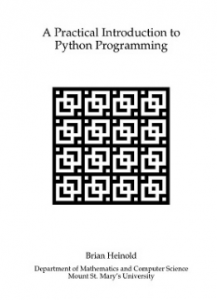 Free Download A Practical Introduction to Python Programming in PDF written by Brian Heinold (Department of Mathematics and Computer Science Mount St. Mary’s University).
Free Download A Practical Introduction to Python Programming in PDF written by Brian Heinold (Department of Mathematics and Computer Science Mount St. Mary’s University).
According to the Author, “My goal here is for something that is partly a tutorial and partly a reference book. I like how tutorials get you up and running quickly, but they can often be a little wordy and disorganized. Reference books contain a lot of good information, but they are are often too terse, and they don’t often give you a sense of what is important. My aim here is for something in the spirit of a tutorial but still useful as a reference. I summarize information in tables and give a lot of short example programs. I also like to jump right into things and fill in background information as I go, rather than covering the background material first.
In terms of structuring a course around this book “A Practical Introduction to Python Programming” or learning on your own, the basis is most of Part I. The first four chapters are critically important. Chapter 5 is useful, but not all of it is critical. Chapter 6(strings) should be done before Chapter 7(lists). Chapter 8 contains some more advanced list topics. Much of this can be skipped, though it is all interesting and useful. In particular, that chapter covers list comprehensions, which I use extensively later in the book. While you can get away without using list comprehensions,they provide an elegant and efficient way of doing things. Chapter 9 (while loops) is important. Chapter 10 contains a bunch of miscellaneous topics, all of which are useful, but many can be skipped if need be. The final four chapters of Part I are about dictionaries, text files, functions, and object-oriented programming.
Part II is about graphics, mostly GUI programming with Tkinter. You can very quickly write some nice programs using Tkinter.
Part III contains a lot of the fun and interesting things you can do with Python. If you are structuring a one-semester course around this book, you might want to pick a few topics in Part III to go over. Thispartofthebookcouldalsoserveasareferenceorasaplaceforinterestedandmotivated students to learn more. All of the topics in this part of the book are things that I have found useful at one point or another.
Though this book was designed to be used in an introductory programming course,it is also useful for those with prior programming experience looking to learn Python. If you are one of those people, you should be able to breeze through the first several chapters. You should find Part II to be a concise, but not superficial, treatment on GUI programming. Part III contains information on the features of Python that allow you to accomplish big things with surprisingly little code.
Table of Contents
- Basics, Getting Started, Installing Python
- For Loops
- Numbers
- If Statements
- Counting, Summing, Swapping, Comments, Example Programs
- Strings
- Lists
- More with Lists
- While Loops
- Boolean, Shortcuts, Continuation, Pass, Nested Loops
- Dictionaries
- Text Files
- Functions
- Object Oriented Programming
- Graphics, GUI Programming with Tkinter
- GUI Programming: Frames, Colors, Images, Canvases
- GUI Programming: Title bar, Disabling Things, Widgets, Boxes
- Further Graphical Programming
- Mutability and References, Tuples, Sets
- Useful Modules
- Regular Expressions
- Math
- Working with Functions
- The Itertools and Collections Modules
- Exceptions
- Bibliography
Free download A Practical Introduction to Python Programming in PDF written by Brian Heinold from following download links.
Password for Download Links: ComputingSavvy
File Size: 2 MB Pages: 263 Please Read Disclaimer
Don’t forget to drop a comment below after downloading this book.
Note: If download links are not working, kindly drop a comment below, so we’ll update the download link for you
Happy downloading!
Also Available: Free Download Python 3.7.2 for Windows